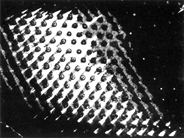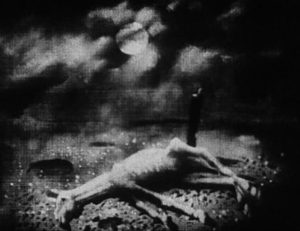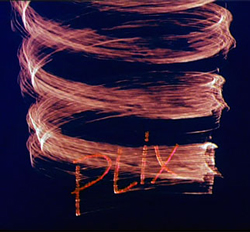
 |
|
|
|
It's not very often that a video release offers a close look at a cinematic specialty as unique as this one. Facets Video's The Animation of Alexeïeff examines the life's work of an illustrator and visual experimentalist who created his own animation art form, as well as camera techniques that presaged later special effects processes. 
A product of the fertile 1920s arts scene in Paris, Alexandre Alexeïeff invented the animation pinscreen, an easel-sized white board pierced with thousands of tiny moveable pins. When pushed in or out, the pin shadows create patterns of black, white or any shade of gray in between. The effect can look like a charcoal sketch, usually with a hint of the pinscreen pattern showing through lightly. Alexeïeff's pinscreen illustrations graced editions of Boris Pasternak's Doctor Zhivago and Fyodor Dostoevsky's Brothers Karamazov. As an animation tool the pinscreen requires no cels, drawings or conventional artwork. After developing a number of specialized techniques with his wife and collaborator Claire Parker, Alexeïeff released his first animated pinscreen film in 1933, the eight-minute A Night on Bald Mountain. Ghostly imagery of a demonic celebration is set to Modest Mussorgski's orchestral tone poem. Under a stormy night sky a scarecrow's rags come to life and a fallen horse is raised from the dead; demons tumble and cavort in the dark clouds. 
Pinscreen work is filmed frame by frame in the normal way, but each frame must be shadow-sculpted into the easel's forest of pins. Keeping the background moving while shaded "dimensional" figures turn in the light demands superhuman concentration; the animator must imagine the evolution of a complex image in time-depth, one frozen frame after another. In one of the disc's documentaries Alexeïeff opines that he's invented the least economical of film techniques, judging by how long it takes to produce a film. But the results are unlike any other kind of animation. 
Alexeïeff and Parker improvised strange tools to sculpt the pins in uniform patterns: little rollers, shaped cut-outs, rounded wooden Russian dolls. The sometimes-visible texture of the pinscreen itself invites comparisons with the painting style pointillism, and vintage illustration techniques that use fine lines to create shadings. Some of the films appear to use double exposures to create complexity within the frame. Alexeïeff found that the pinscreen could support a variety of styles. The brief En Passant (1944) envisions a lively barnyard scene set to a French Canadian song. Animal characters seem to sketch themselves, move about and then transform into other shapes as needed. The 1963 The Nose is based on a satirical short story by Nikolai Gogol. It takes an architectural approach to scenes, adding and shifting shapes instead of animating full motion. To move a character indoors, a wall might rotate into a new position, or slide away to reveal a new door. But the most impressive pinscreen effects create suggestive, abstract imagery. One visual in 1980's Three Moods presents dreamlike, out-of-focus shapes that suggest shadows of plants on a window curtain. The technique reduces the image to just a few visual clues. 
Alexandre Alexeïeff and Claire Parker filmed only a few pinscreen works; all are included on this disc save for a noted prologue he created for Orson Welles' 1962 feature film The Trial. From almost the beginning they produced theatrical film advertisements, twenty of which are presented here. They mainly use conventional stop-motion animation and are filmed in various color processes. Cigarettes march like soldiers and an oil derrick is made to look like a Christmas tree, sprouting crystal bubbles of petroleum. As the ads move into the 1950s Alexeïeff's film techniques become increasingly sophisticated. Multi-exposure and stroboscopic cinematography are combined with time-lapse tricks to make logos for Esso and Gitanes twist, stretch and distort in odd ways. A Cocinor logo fans out in a complex pattern using what Alexeïeff called "totalization". The effect looks very similar to the "slit-scan" technique perfected by Douglas Trumbull for 2001: A Space Odyssey. Most of the technical innovations we know from 1970s motion control graphics work are already fully developed in these early theatrical ads. 
The disc also contains several Alexeïeff tests for photographing pendulums, an effect that closely resembles the oscilloscope waveforms in later avant-garde experiments by John Whitney. The technique shows up in the French advertisements as wispy animated smoke rings for cigarette commercials. In addition to Alexeïeff and Parker's pinscreen movies, theatrical commercials and effects tests, The Animation of Alexeïeff contains three docu pieces. A brief filmic look at the illustrations for Doctor Zhivago shows some of the artist's unusual rolling tools. Norman McLaren's 1972 The Pinscreen documents a workshop seminar for a group of Film Board of Canada artists and animators. The husband & wife team demonstrate every principle of their pinscreen, literally passing the secrets of their personal art form to a new generation. When the students give it a try, they create some very interesting and stylistically varied work. A third short piece shows Alexeïeff and Parker at work on Three Moods. In the color view of their studio the pinboard seems an island of grays and blacks. A separate still gallery has pictures of the screens, Alexeïeff's odd toolbox and other archival stills of the couple at work. The final piece is Jacques Drouin's 1976 Film Board of Canada short subject Mindscape (Le Paysagiste), an incredibly complex pinboard masterpiece. An artist climbs into his own landscape painting, producing a flow of evolving images. It's like watching an artist compose a living painting. 
Facets Video's DVD of The Animation of Alexeïeff is a production of Cinédoc / Paris Films; occasional French language dialogue and text are not translated. All of the film selections are transferred well, although the older Night on Bald Mountain looks slightly the worse for wear. An illustrated insert booklet contains a biographical sketch by Facets' Susan Doll and a more analytical essay by Dominique Willoughby. The essay is translated from French and sometimes encounters difficulty communicating Alexeïeff's special techniques and semi-abstract concepts: "totalized animation"; "illusory solids". More photos and information on Alexandre Alexeïeff and pinboard animation can be seen at this Film Board of Canada page: Pinscreen Techniques by Marcel Jean.
On a scale of Excellent, Good, Fair, and Poor,
The Animation of Alexeïeff rates:
Reviews on the Savant main site have additional credits information and are often updated and annotated with reader input and graphics. Also, don't forget the 2009 Savant Wish List. T'was Ever Thus.
Review Staff | About DVD Talk | Newsletter Subscribe | Join DVD Talk Forum |
| ||||||||||||||||||